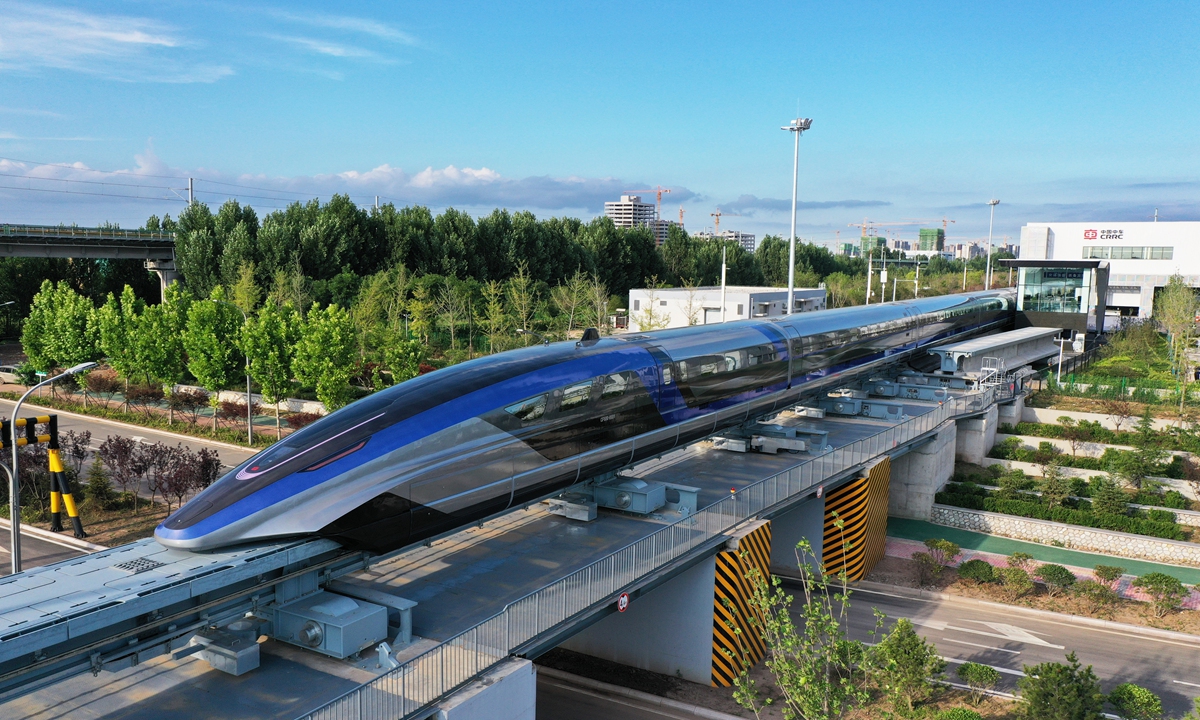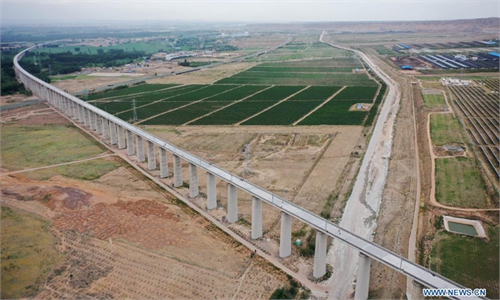
Photo taken on Tuesday shows China's new maglev transportation system in Qingdao, east China's Shandong Province. It is currently the world's fastest ground vehicle. Photo: cnsphoto
China's self-developed and the world's fastest maglev transportation system with a speed of 600 kilometers per hour rolled off the assembly line on Tuesday in Qingdao, East China's Shandong Province, marking another crucial milestone in the country's rapid rise as a global leader in high-speed rail technology and manufacturing and in its broad, ambitious goals to accelerate urbanization and build a modern socialist power.
The maglev train can fill the gap between the current high-speed train that runs at around 350 km/h and airplanes with a speed of 800 km/h, which will support China's comprehensive transportation network planned by 2035, analysts noted.
The maglev train is currently the fastest available ground vehicle. It is the fastest method of surface transportation within the range of 1,500 kilometers, according to a report by the CRRC sent to the Global Times on Tuesday. What is currently a 10-hour high-speed train trip from South China's Shenzhen to Shanghai will be shortened to only 2.5 hours once a maglev train is built.
The new maglev train showcases a number of technological breakthroughs and advances, including a self-developed brake system that is 30 percent more efficient than the Shanghai maglev train, which means that the braking distance is reduced from about 16 kilometers to 10 kilometers, CRRC Qingdao Sifang Rolling Stock Research Institute (CRRC SRI) told the Global Times on Tuesday.
CRRC SRI provides the braking system, coupler, anti-vibration system, electricity system, passenger information system (PIS) and other core components of the 600 km/h maglev train.
CRRC technicians spent 19 months developing the magnetic poles for whirlpool brakes on the maglev train, which can be recycled in an -25 C to 170 C environment and can withstand vibrations.
Its power supply system is one of the key systems of the high-speed maglev train, which plays an important role in the safe operation of the train. When the speed exceeds 100 km/h, a non-contact power supply is adopted. The train receiver system developed by CRRC SRI has good environmental adaptability and can work smoothly from -25 C to 45 C, CRRC SRI said.
Researchers developed an articulated coupler for the train by using forged aluminum alloys as the key structural part, which ensured that the relative motion between the train cars is less than 1 millimeter, Jiang Yulong, the project leader of coupler at CRRC SRI, told the Global Times.
The coupler length is only 280 millimeters, and weighs less than 30 kilograms, which meets the extremely spatial requirements of the maglev train, Jiang introduced.
To guarantee smooth telecommunication during a high-speed run, 5G is reserved for the Wi-Fi system, and passengers will be able to charge their mobile phones wirelessly.
The maglev project started in October 2016, with a prototype vehicle successfully developed in 2019 and making a trial run in June 2020. After system optimization, the final technical set was determined in January, and the complete system then started a six-month test, according to CRRC.
The maglev train can be configured from 2 to 10 cars, each capable of accommodating more than 100 passengers, to meet different needs.
"The 600 km/h high speed maglev transportation system means that the complete set of high-speed maglev train technologies is further mature and closer to the commercial landing. The realization of fully independent and controllable technologies can significantly reduce the cost of technological application, and will facilitate large-scale application," Zhang Xiaoxing, a lecturer of the School of Architecture at the South China University of Technology, told the Global Times on Tuesday.
Shanghai, China's financial hub, is the only Chinese city operating a commercial high-speed maglev line, with a top speed of 430 km per hour. The Shanghai maglev train using German technology has been in operation since 2003, linking downtown Shanghai to the city's Pudong airport.
By the end of 2020, the total length of China's railways was 146,300 kilometers, with the total mileage of the high-speed railway network at 38,000 kilometers, according to National Railway Administration data.
China has the largest network of high-speed railways in the world, covering 95 percent of cities with a population of more than a million, according to the Ministry of Transport.
China aims to build 200,000 kilometers of railways, 460,000 kilometers of highways, and 25,000 kilometers of high-level sea lanes by 2035, according to a 15-year transport expansion guideline published in February this year.
The network is designed to support the "National 123" transportation circle, which stands for one-hour commute within the city, two-hour trip between city clusters and three-hour travel to major cities nationwide, read the plan.
Lu Huapu, director of the Transportation Research Institute of Tsinghua University, told the Global Times that the development of the high-speed transportation system helps China realize the "National 123 transportation circle," which was proposed in the national guideline.
The maglev transportation system can greatly improve the quality and efficiency of transportation and change the characteristics of economic and geographical location and regional competitiveness, Lu said.
The system will also help consolidate China's leading position in high-speed rail technology and is of great significance to promote the development and upgrading of related industries, analysts said.
In global maglev train-related patents, China is first in terms of the accumulated number of patent applications by 2021, accounting for 43.52 percent, significantly higher than the 20.57 percent of Japan which took the second place, according to a report sent to the Global Times on Tuesday by PatSnap, an intelligent property data service provider.
Japan's patents focus on the research and development of superconducting materials and basic science, while China's patents focused more on practice, including permanent magnets, rail beams, traffic engineering and suspension frame, per the PatSnap report.
The 600 km/h high-speed maglev transportation system will be more likely first used in Guangzhou-Shenzhen-Hong Kong and Shanghai-Hangzhou high-speed maglev channels, as the high-quality development of core cities and town clusters along the routes is the decisive factor, said Zhang.
But Zhao Jian, a professor with Beijing Jiaotong University, said that it is unlikely to export China's maglev train and relevant technologies in the near future, as other countries lack the scale to make the maglev lines profitable.
"The maglev lines can earn money only when a network of high-speed transportation is formed, with huge passenger flows," Zhao told the Global Times on Tuesday.

